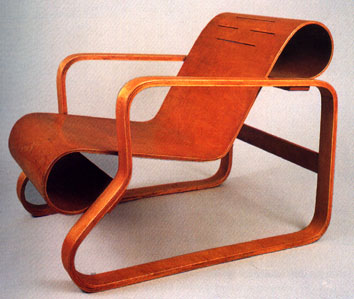|
Hugo Alvar Hendrik Aalto When one thinks of Alvar Aalto images of laminated wood and plywood furniture instantly spring to mind. Alvar experimented with a variety of construction materials including tubular steel but he made the most significant technical innovations using laminated materials such as birch and plywood. |
 |
|
Originally Alvar studied to become an architect in Helsinki but eventually found himself working as an exhibition designer and travelled extensively in central Europe, Italy and Scandinavia. In 1924 he married the designer, Aino Marsio and together and for five
years they experimented with the bending of wood. This research
led to Alvar's revolutionary designs of the 1930's. Alvar began bonding
veneers together and moulding plywood. These experiments led to
one of the most innovative chairs at the time which he named Model
No.41. The chair is made from laminated and solid birch frame. Birch is a very flexible and springy material. The seat is made from bent plywood which has been heavily lacquered. The scrolls at the back of the chair have been bent into such a shape by removing several layers of the plywood veneer. |
|
 |
Alvar also designed and made Model No.31 at around the same period. This was a cantilevered chair. Both were very contemporary at the time. It was the first chair to use laminated wood in a cantilever structure. The designs began a new trend in the use of laminated woods and plywood. The furniture proved to be very successful with the public and as a result Alvar and his wife set up a company selling the furniture. The company was named Artek and was set up in 1935.
|
|
The image above shows the Model No.31(the cantilever laminated wood chair). Alvar believed that his most important contribution to furniture design was his solving of an age old problem, which was how to connect vertical and horizontal pieces of material. In order to do this a framework usually has to be built, joints cut or standard components such as screws, bolts or nails used. Alvar's bentwood solutions allowed legs to be joined directly to the underside of a seat or a table without the need for a framework or any additional support. This technique was used to construct such beautiful pieces as his series of L-Leg stools (1932-1933). Y-Leg stools (1946-1947) and Fan-leg stools (1954). The L-Leg stool (Model No.60) demonstrates Alvar's interest in basic functional forms. It is made from laminated birch. |
|
|
Alvar's furniture has an organic appearance. It does not look like other furniture of the same period, which appeared to be angular, sharp and made of polished tubular steel. This furniture looked mass-produced whereas Alvar's chairs look like they have been individually made by skilled craftsmen using natural materials. For example if you take a look at the vase underneath named the Savoy vase of 1937, originally named the 'Eskimoerindens skinnbuxa', which means the Eskimo woman's leather trousers. It is said to be inspired by the fjord shorelines of Alvar's native Finland. |
|
 |
Alvar strongly believed that design should be both natural and organic. He rejected man-made materials such as tubular steel in furniture. He felt that these materials were alien and were not materials that made us feel a part of nature. Alvar's furniture was well received both in Britain and America during the 1930's and 1940's. His philosophy of design was influenced by nature and organic materials. After the Second World War Alvar's philosophy influenced such designers as Charles and Ray Eames. |
|
Alvar's influences were very different than the Modern Movement at
the time. He rejected mass- production, the machine finish and the whole
efficient elimination of decorative shape and pattern that was so important
to the Modern Movement. This Movement was keen to eliminate any excess
time, waste of labour or materials. Their main concern was the pure function
of a product. Alvar is quoted as saying '' The best standardization committee in the world is nature herself, but in nature standardization occurs mainly in connection with the smallest possible unit cells. The result is millions of flexible combinations in which one never encounters the stereotyped''. This quotation was cited in Andrei Gozak, Alvar Aalto versus the Modern Movement, Helsinki 1981. The image below shows Model No.98. A tea trolley for Artek. Consider
the smooth curved bent plywood and the lack of any foreign standard components
such as screws or knockdown joints. |
|
 |
|
|
Organic design must be treated as a holistic approach. For example the whole interior of a room must be carefully considered and everything in that room must compliment one another. The complete effect is thought to be more important than the sum of its individual parts. Crucial to organic design was the consideration of how individual elements such as pieces of furniture and ornaments connect both visually and functionally with the rest of the room and even building as a whole. This could be achieved through the correct choice of colours, materials and shapes. Alvar believed that wood was ''the form-inspiring, deeply human materials''. He rejected such materials as tubular steel, which were quite modern at the time. Alvar's furniture was so popular in America that he virtually changed the course of design towards organic Modernism.
|
|